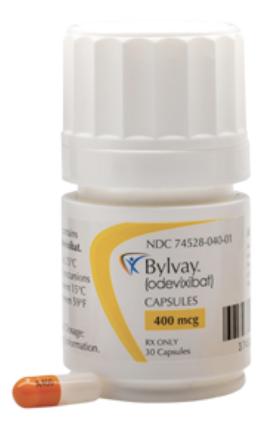Odevixibat Dosage
Medically reviewed by Drugs.com. Last updated on Mar 25, 2025.
Applies to the following strengths: 200 mcg; 400 mcg; 600 mcg; 1200 mcg
Usual Adult Dose for:
- Pruritus
- Pruritus of Partial Biliary Obstruction
- Progressive Familial Intrahepatic Cholestasis
- Arteriohepatic Dysplasia
Usual Pediatric Dose for:
- Pruritus
- Pruritus of Partial Biliary Obstruction
- Progressive Familial Intrahepatic Cholestasis
- Arteriohepatic Dysplasia
Additional dosage information:
Usual Adult Dose for Pruritus
Initial dose: 40 mcg/kg orally once a day (in the morning)
Maintenance dose: 40 to 120 mcg/kg orally once a day (in the morning)
Maximum dose: 6 mg/day
Comments:
- Patients should be given oral pellet formulations if they weigh less than 19.5 kg; those who weigh 19.5 kg or more should be given capsule formulations.
- The dose may be increased in 40 mg/kg increments after 3 months if pruritus does not improve.
Use: Treatment of pruritus in patients with progressive familial intrahepatic cholestasis (PFIC)
Usual Adult Dose for Pruritus of Partial Biliary Obstruction
Initial dose: 40 mcg/kg orally once a day (in the morning)
Maintenance dose: 40 to 120 mcg/kg orally once a day (in the morning)
Maximum dose: 6 mg/day
Comments:
- Patients should be given oral pellet formulations if they weigh less than 19.5 kg; those who weigh 19.5 kg or more should be given capsule formulations.
- The dose may be increased in 40 mg/kg increments after 3 months if pruritus does not improve.
Use: Treatment of pruritus in patients with progressive familial intrahepatic cholestasis (PFIC)
Usual Adult Dose for Progressive Familial Intrahepatic Cholestasis
Initial dose: 40 mcg/kg orally once a day (in the morning)
Maintenance dose: 40 to 120 mcg/kg orally once a day (in the morning)
Maximum dose: 6 mg/day
Comments:
- Patients should be given oral pellet formulations if they weigh less than 19.5 kg; those who weigh 19.5 kg or more should be given capsule formulations.
- The dose may be increased in 40 mg/kg increments after 3 months if pruritus does not improve.
Use: Treatment of pruritus in patients with progressive familial intrahepatic cholestasis (PFIC)
Usual Adult Dose for Arteriohepatic Dysplasia
USUAL ADULT DOSE (ALGS):
Initial dose: 120 mcg/kg orally once a day (in the morning)
Maintenance dose: 120 mcg/kg orally once a day (in the morning)
Maximum dose: 7.2 mg/day
Comment:
- Patients should be given oral pellet formulations if they weigh less than 19.5 kg; those who weigh 19.5 kg or more should be given capsule formulations.
Use: Treatment of cholestatic pruritus in patients with alagille syndrome (ALGS)
Usual Pediatric Dose for Pruritus
3 months and older:
- Initial dose: 40 mcg/kg orally once a day (in the morning)
- Maintenance dose: 40 to 120 mcg/kg orally once a day (in the morning)
- Maximum dose: 6 mg/day
Comments:
- Patients should be given oral pellet formulations if they weigh less than 19.5 kg; those who weigh 19.5 kg or more should be given capsule formulations.
- The dose may be increased in 40 mg/kg increments after 3 months if pruritus does not improve.
Use: Treatment of pruritus in patients with PFIC
Usual Pediatric Dose for Pruritus of Partial Biliary Obstruction
3 months and older:
- Initial dose: 40 mcg/kg orally once a day (in the morning)
- Maintenance dose: 40 to 120 mcg/kg orally once a day (in the morning)
- Maximum dose: 6 mg/day
Comments:
- Patients should be given oral pellet formulations if they weigh less than 19.5 kg; those who weigh 19.5 kg or more should be given capsule formulations.
- The dose may be increased in 40 mg/kg increments after 3 months if pruritus does not improve.
Use: Treatment of pruritus in patients with PFIC
Usual Pediatric Dose for Progressive Familial Intrahepatic Cholestasis
3 months and older:
- Initial dose: 40 mcg/kg orally once a day (in the morning)
- Maintenance dose: 40 to 120 mcg/kg orally once a day (in the morning)
- Maximum dose: 6 mg/day
Comments:
- Patients should be given oral pellet formulations if they weigh less than 19.5 kg; those who weigh 19.5 kg or more should be given capsule formulations.
- The dose may be increased in 40 mg/kg increments after 3 months if pruritus does not improve.
Use: Treatment of pruritus in patients with PFIC
Usual Pediatric Dose for Arteriohepatic Dysplasia
12 months and older:
Initial dose: 120 mcg/kg orally once a day (in the morning)
Maintenance dose: 120 mcg/kg orally once a day (in the morning)
Maximum dose: 7.2 mg/day
Comment:
- Patients should be given oral pellet formulations if they weigh less than 19.5 kg; those who weigh 19.5 kg or more should be given capsule formulations.
Use: Treatment of pruritus in patients with alagille syndrome (ALGS)
Renal Dose Adjustments
Data not available
Liver Dose Adjustments
Patients with clinically significant portal hypertension or with decompensated cirrhosis: Data not available; frequent monitoring recommended.
Prior to and during treatment: Liver function tests (e.g., ALT, AST, direct bilirubin, total bilirubin, INR) should be monitored.
During treatment:
- Treatment should be interrupted if new onset liver function test abnormalities occur OR clinical hepatitis symptoms are observed.
- If abnormalities return to baseline OR stabilized at a new baseline value, providers may consider restarting this drug at 40 mcg/kg orally once a day, and increasing the dose if needed; patients who develop recurring liver test abnormalities should permanently discontinue treatment.
- Patients who develop portal hypertension or hepatic decompensation events (e.g., ascites, hepatic encephalopathy, variceal hemorrhage) should permanently discontinue treatment.
Dose Adjustments
Diarrhea:
- Patients should be monitored for dehydration and should be treated promptly.
- Treatment should be interrupted if persistent diarrhea occurs.
- This drug should be restarted at 40 mcg/kg orally once a day once diarrhea resolves, and the dose may be increased if needed.
- Patients who develop persistent diarrhea without an identifiable alternative etiology should discontinue treatment.
Fat-Soluble Vitamin (FSV) Deficiency:
- Treatment should be discontinued if FSV deficiencies persist or worsen despite appropriate supplementation.
Tolerability for Alagille Syndrome (ALGS):
- The dose may be reduced to 40 mcg/kg/day if treatment is not tolerated after ruling out other causes. Once tolerability is stable, resume treatment at 120 mcg/kg/day.
Precautions
CONTRAINDICATIONS:
- Hypersensitivity to the active component or any of the ingredients
Safety and efficacy have not been established in patients younger than 3 months.
Consult WARNINGS section for additional precautions.
Dialysis
Data not available
Other Comments
Administration advice:
- This drug should be taken with a meal.
- Capsules should not be crushed or chewed.
- Capsules may be opened and sprinkled on soft food or liquid.
- This drug should be taken at least 4 hours before or after taking bile acid binding resins (if needed).
Reconstitution/preparation techniques: The manufacturer product information should be consulted.
General:
- LIMITATION OF USE: This drug may not be effective in patients with PFIC type 2 with ABCB11 gene variants that result in the functional/complete absence of bile salt export pump protein (BSEP-3).
Monitoring:
- HEMATOLOGIC: INR at baseline and then throughout treatment
- HEPATIC: Liver function tests prior to starting and then throughout treatment
- METABOLIC: FSV levels at baseline and then throughout treatment
Patient advice:
- Advise patients to speak to their healthcare provider if they become pregnant, intend to become pregnant, or are breastfeeding.
More about odevixibat
- Check interactions
- Compare alternatives
- Side effects
- During pregnancy
- Drug class: miscellaneous GI agents
- En español
Patient resources
Other brands
Professional resources
Other brands
Related treatment guides
See also:
Further information
Always consult your healthcare provider to ensure the information displayed on this page applies to your personal circumstances.


